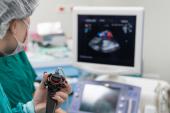AHA Advice for Rare but Deadly Mechanical Complications of Acute MI
The lack of clinical trial data on this population means nuanced management is often needed, along with a good heart team.

Although very few patients develop mechanical complications after an acute MI, for those who do, outcomes are poor and much more work is needed to inform best practices and boost survival rates, according to a new scientific statement from the American Heart Association (AHA).
Writing group chair Abdulla A. Damluji, MD, PhD (Johns Hopkins University Inova Center of Outcomes Research, Baltimore, MD), told TCTMD that the statement is intended to provide guidance to clinicians in light of the lack of clinical trial evidence on the safety and efficacy of various treatments.
“This patient population is quite difficult to enroll in any clinical trials,” he noted, adding that the emergent nature of the complications would make the consent process difficult.
The overall incidence of mechanical complications is low, accounting for < 1% of total acute MI cases, Damluji said. However, fatality rates among those with mechanical complications are 50% or greater and have remained relatively flat over several decades despite greater use of mechanical circulatory support devices, percutaneous procedures for managing some complications of shock, and improvements in surgical techniques and outcomes. Around the world, there have also been increased reports of mechanical complications during the COVID-19 pandemic, blamed in many cases on patients hoping to avoid hospital admissions.
“Clinicians sometimes either don't look for these complications, or patients die, or they get transferred to quaternary centers once they are diagnosed,” Damluji added. Typically, hospital stays for those who do survive are long, involve multiple therapies and expertise from a variety of specialties, and are expensive. The scientific statement, rather than providing guidelines, is meant to summarize what physicians and hospitals can expect when accepting these patients, he said.
Multidisciplinary Collaboration Needed
The statement, which was published this week in Circulation, covers presentation, diagnosis, management, and mortality rates for four major types of mechanical complication: papillary muscle rupture and acute mitral regurgitation, ventricular septal defect, rupture of the ventricular free wall, and pseudoaneurysm.
The first step, Damluji emphasized, should always be immediate cardiac imaging.
“That's where the first subspecialty comes into place to diagnose these patients. Most of them are hemodynamically unstable,” he said. Imaging as a first step is especially important if patients are presenting to a rural hospital or center that does not have the capabilities that will be needed to treat a major mechanical complication and will need to initiate a transfer to a specialized center.
Without an evidence base to draw from for recommendations, Damluji said the writing panel and reviewers talked through the suggestions and tried to be inclusive regarding their management advice.
“For example, for papillary muscle rupture and severe acute mitral regurgitation after acute myocardial infarction, we suggested that mitral valve replacement is the treatment of choice. But, some surgeons said they would be able to do a repair if the hemodynamics are stable and if you have partial rupture rather than a full rupture, and we included that,” he said. The statement also notes that patient preferences and values must be considered in any high-morbidity/mortality treatment decisions.
For ventricular septal defect, immediate afterload reduction is described by Damluji and colleagues as “the mainstay of initial therapy,” followed by surgery, the timing of which requires multidisciplinary discussion between a cardiac surgeon, cardiologist, and cardiac intensivist. They add that the severity of cardiogenic shock, organ failure, and risk of coagulopathy from antiplatelet therapy should be factored into the decision-making, adding that options for those who are not surgical candidates may include percutaneous closure, mechanical support to transplant, and palliative medical therapy.
Free wall rupture, the most commonly reported mechanical complication of acute MI, often results in sudden cardiac death. In cases of high suspicion of this complication, Damluji and colleagues say immediate surgery is needed, often with extracorporeal membrane oxygenation for preoperative stabilization. In some cases, they add, a primary patch repair that covers the defect may be considered; other options include a sutureless repair with a patch and glue or a collagen sponge patch.
LV pseudoaneurysm and LV aneurysms, while rare, require urgent surgical intervention. However, Damluji and colleagues note that with a heart team approach, percutaneous repair may be an option at centers with a high level of expertise in structural heart disease.
Other Considerations and Future Work
The statement also discusses situations in which heart replacement may be necessary for patients with biventricular failure and associated end-organ impairment, for example, who are considered to be poor surgical and transcatheter candidates. “Although concerns linger regarding perioperative mortality in these patients, this therapeutic option may be a successful bridge or destination therapy for select patients with mechanical complications of acute MI if surgery or catheter-based therapies are not feasible,” Damluji and colleagues write.
In light of the high risk of multisystem sequelae, the statement also points out that patients with mechanical complications often need critical care support for end-organ dysfunction, “and are likely to benefit from a team-based approach for decision-making in the cardiac ICU.” Such a team will likely include critical care nurses, respiratory therapists, clinical pharmacists, a palliative care team, and family members, in addition to the surgeon, cardiologist, and intensivist.
Damluji said palliative care is an important, though not often discussed, element in the treatment of mechanical complications for symptomatic relief. Like some other items in the statement, it had to be included with the caveat that there are no concrete data in this population.
“It makes sense that we approach palliative care from other disease processes, but has this been studied in mechanical complications? The answer is no,” he added.
Although there have been reports over the last year that ventricular wall and papillary muscle ruptures have increased in incidence as a result of patients delaying care due to COVID-19 restrictions or fears about contracting the coronavirus, Damluji told TCTMD that the AHA statement was initiated prior to the pandemic. While the issue was raised in the review process, the statement ultimately did not include a discussion about COVID-19-related patients.
Not surprisingly, the statement also addresses research gaps and ways to improve the gathering of information in patients with mechanical complications. Among the suggestions are to study mechanical complications in a manner similar to rare diseases, thus allowing for study designs that account for small patient populations. Another thought is to create a registry, as has been done with acute aortic dissection and pulmonary hypertension, allowing for a prospective cohort or even a pragmatic trial across these centers through an as-yet-unknown collaboration.
“If there are 10 centers across the US or even outside the US who are interested in enrolling these patients, a specialized prospective cohort study to collect data on safety and efficacy of some of these devices or therapies can be feasible,” Damluji said. “But it has to be endorsed by industry, or by the NIH or the FDA, [in order for that] to happen. This document is, I think, the first step towards that goal.”
L.A. McKeown is a Senior Medical Journalist for TCTMD, the Section Editor of CV Team Forum, and Senior Medical…
Read Full BioSources
Damluji AA, van Diepen S, Katz JN, et al. [Mechanical complications of acute myocardial infarction: a scientific statement from the American Heart Association.]( https://www.ahajournals.org/doi/10.1161/CIR.0000000000000985Damluji reports a grant from the National Heart, Lung, and Blood Institute.
Disclosures
- Damluji reports a grant from the National Heart, Lung, and Blood Institute.





Comments